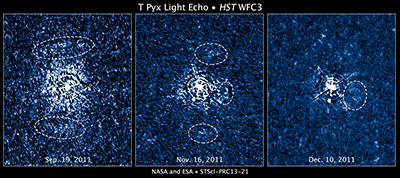HUBBLE MAPS 3-D STRUCTURE OF EJECTED MATERIAL AROUND ERUPTING STAR
2013-06-04
Astronomers used NASA's Hubble Space Telescope to observe the light emitted by the close double-star system T Pyxidis, or T Pyx, a recurring nova, during its latest outburst in April 2011.
A nova erupts when a white dwarf, the burned-out core of a sun-like star, has siphoned off enough hydrogen from a companion star to trigger a thermonuclear runaway. As hydrogen builds up on the surface of the white dwarf, it becomes hotter and denser until it detonates like a colossal hydrogen bomb, leading to a 10,000-fold increase in brightness in a little more than one day. Nova explosions are extremely powerful, equal to a blast of one million billion tons of dynamite. T Pyx erupts every 12 to 50 years.
Contrary to some predictions, the astronomers were surprised to find the ejecta from earlier outbursts stayed in the vicinity of the star and formed a disk of debris around the nova. The discovery suggests material continues expanding outward along the system's orbital plane, but it does not escape the system.
"We fully expected this to be a spherical shell," says Arlin Crotts of Columbia University, a member of the research team. "This observation shows it is a disk, and it is populated with fast-moving ejecta from previous outbursts."
Team member Stephen Lawrence of Hofstra University in Hempstead, N.Y., will present the results Tuesday at the American Astronomical Society meeting in Indianapolis. See the webside for more details:http://hubblesite.org/newscenter/archive/releases/2013/21/text/(SY)

 Search
Search

